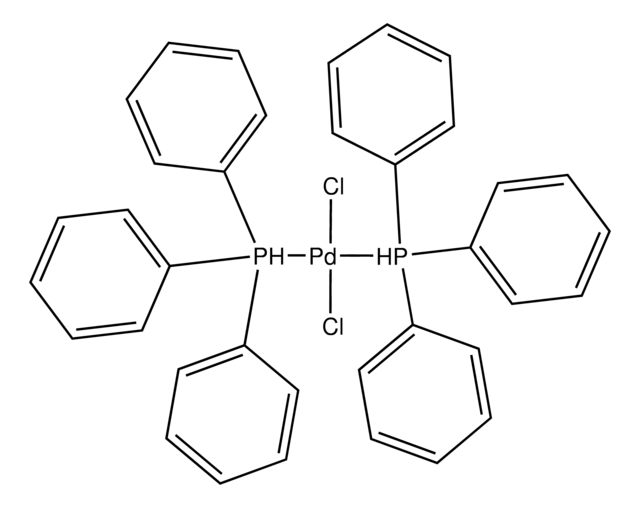We would recommend using a metallic scavenger like the QuadraPureTM products. Product numbers 655422 and 657662 are designed to scavenge palladium ions and are effective in both acidic and basic conditions. The resins are capable of removing metallic contamination to very low levels and are ideal for pharmaceutical or fine chemical processing.
520764
[Pd(OAc)2]3
≥99.9% trace metals basis
Sinônimo(s):
Pd(OAc)2
Selecione um tamanho
Selecione um tamanho
About This Item
Produtos recomendados
Nível de qualidade
Ensaio
≥99.9% trace metals basis
adequação da reação
core: palladium
reaction type: Buchwald-Hartwig Cross Coupling Reaction
reaction type: Cross Couplings
reaction type: Heck Reaction
reaction type: Hiyama Coupling
reaction type: Negishi Coupling
reaction type: Sonogashira Coupling
reaction type: Stille Coupling
reaction type: Suzuki-Miyaura Coupling
reagent type: catalyst
reaction type: C-H Activation
pf
216.3-223.7 °C (dec.)
cadeia de caracteres SMILES
CC(O[Pd]OC(C)=O)=O
InChI
1S/2C2H4O2.Pd/c2*1-2(3)4;/h2*1H3,(H,3,4);/q;;+2/p-2
chave InChI
YJVFFLUZDVXJQI-UHFFFAOYSA-L
Procurando produtos similares? Visita Guia de comparação de produtos
Descrição geral
Aplicação
- Formation of allylic acetates.[5] (eq. 1)
- Hydroselenation of triple bonds.[6] (eq. 2)
- Heck arylation of alkenes.[7] (eq. 3)
- Cyclocarbonylation.[8] (eq. 4)
- Buchwald-Hartwig amination reaction.[9] (eq. 5)

For small scale and high throughput uses, product is also available as ChemBeads (924377)
produto relacionado
Palavra indicadora
Danger
Frases de perigo
Declarações de precaução
Classificações de perigo
Aquatic Acute 1 - Aquatic Chronic 1 - Eye Dam. 1 - Skin Sens. 1A
Código de classe de armazenamento
11 - Combustible Solids
Classe de risco de água (WGK)
WGK 2
Ponto de fulgor (°F)
Not applicable
Ponto de fulgor (°C)
Not applicable
Equipamento de proteção individual
dust mask type N95 (US), Eyeshields, Gloves
Escolha uma das versões mais recentes:
Certificados de análise (COA)
Não está vendo a versão correta?
Se precisar de uma versão específica, você pode procurar um certificado específico pelo número do lote ou da remessa.
Já possui este produto?
Encontre a documentação dos produtos que você adquiriu recentemente na biblioteca de documentos.
Os clientes também visualizaram
-
When using are Product 520764, Palladium (II) acetate, what can I use to remove traces of palladium that this catalyst may leave behind?
1 answer-
Helpful?
-
-
What reactions are Product 520764, Palladium (II) acetate, used in?
1 answer-
Palladium (II) acetate is used as a catalyst for a number of reactions, including: Suzuki coupling reactions, (See ChemFiles 2.1 and ChemFiles 4.2) vinylation, (i.e. the Heck Reaction), rearrangement of acyclic dienes (i.e. the Cope Reaction).Papers that cite the use of this reagent are listed below. 1. B.M. Trost Tet. 33, 2615, (1977)2. R.F. Heck Acc. Chem. Res. 12, 146, (1979)3. Tet. 62, 9002, (2006)4. Org. Lett. 8, 3311, (2006) abstract5. Organometallic News 2, 52, (2002)
Helpful?
-
-
What atmosphere is Product 520764, Palladium (II) acetate, packaged under?
1 answer-
This material is packaged under a layer of nitrogen to reduce the chance of moisture contamination.
Helpful?
-
-
What is Product 520764, Palladium (II) acetate, soluble in?
1 answer-
Palladium acetate is not water-soluble; it is organic soluble. Although Sigma-Aldrich does not test solubility of 520764 directly, it is expected to be soluble in most common organic solvents, like chloroform, methylene chloride and acetone, according to the manufacturer.
Helpful?
-
-
What is the difference between Product 520764, Palladium (II) acetate, and the palladium acetate in the form of a ChemDose® tablet?
1 answer-
The ChemDose® products offer a streamlined way to catalyze reactions. The catalyst is dispersed in an inert tablet matrix in specific millimolar and micromolar quantities. The tablets can decrease time spent on weighing/adding the catalyst to the reaction mixture. The tablets effectively give the same reaction yields with a controlled release of the catalyst. They are also extremely easy to remove after the reaction is complete. The inert tablet usually stays intact throughout the reaction. Product 684929 is the ChemDose® tablet that contains 2.0 μmol of palladium (II) acetate, while product#: 685593 is the 10μmol version. More information on these products can be found at the link below.
Helpful?
-
-
What is the Department of Transportation shipping information for this product?
1 answer-
Transportation information can be found in Section 14 of the product's (M)SDS.To access the shipping information for this material, use the link on the product detail page for the product.
Helpful?
-
Active Filters
Nossa equipe de cientistas tem experiência em todas as áreas de pesquisa, incluindo Life Sciences, ciência de materiais, síntese química, cromatografia, química analítica e muitas outras.
Entre em contato com a assistência técnica![[Pd(OAc)2]3 reagent grade, 98%](/deepweb/assets/sigmaaldrich/product/structures/508/249/99a0ef2c-b77c-4d73-8ed9-0cca05b6b41f/640/99a0ef2c-b77c-4d73-8ed9-0cca05b6b41f.png)








![[Pd(acac)2] Umicore, 99%](/deepweb/assets/sigmaaldrich/product/structures/145/685/c3d0f078-c0c6-4ce6-9c4a-b6a1b973b3a9/640/c3d0f078-c0c6-4ce6-9c4a-b6a1b973b3a9.png)


